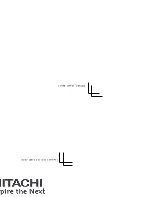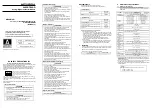
6
Item
General Specifications
Vibration
*10
5.9m/s
2
(0.6G), 10 to 55 Hz
Location
Altitude 1,000m or less, indoors (no corrosive gasses or dust)
Coating color
Black
Options
Remote operator unit, cables for the units, braking unit, braking resistor,
fieldbus
Footnotes for the preceding table and the tables that follow:
Note1:
The protection method conforms to JIC C 0920.
Note2:
The applicable motor refers to Hitachi standard 3-phase motor (4p). When using other
motors, care must be taken to prevent the rated motor current (50/60Hz) from exceeding the
rated output current of the inverter.
N
ote3:
The output voltage decreases as the main supply voltage decreases (except when using
the AVR function). In any case, the output voltage cannot exceed the input power supply voltage.
In any case, the output voltage cannot exceed two times the input power supply voltage
Note4:
To operate the motor beyond 50/60Hz, consult the motor manufacturer for the maximum
allowable rotation speed.
Note5:
At the rated voltage when using a Hitachi standard 3-phase, 4-pole motor.
Note6:
The braking torque via capacitive feedback is the average deceleration torque at the
shortest deceleration (stopping from 50/60Hz as indicated). It is not continuous regenerative
braking torque. The average deceleration torque varies with motor loss. This value decreases
when operating beyond 50Hz. If a large regenerative torque is required, the optional
regenerative braking unit and a resistor should be used.
Note7:
The frequency command is the maximum frequency at 9.8V for input voltage 0 to
10VDC, or at 19.6mA for input current 4 to 20mA. If this characteristic is not satisfactory for
your application, contact your Hitachi representative.
Note8:
If the inverter is operated outside the region shown in the graph in the derating curve,
the inverter may be damaged or its service life may be shortened. Set
B083
Carrier Frequency
Adjustment in accordance with the expected output current level. See derating curve section
for the detailed information of the inverter operating range.
Note9:
The storage temperature refers to the short-term temperature during transportation.
Note10:
Conforms to the test method specified in JIS JIS C 60068-2-6 :2010(IEC
60068-2-6:2007). For the model types excluded in the standard specifications, contact your
Hitachi sales representative.
Note11:
Watt losses are calculated values based on specification of main semi-conductors. You
must take suitable margin when designing cabinet based on these values. Otherwise there is a
possibility of heating trouble.
Note12:
“When the ambient temperature exceeds 40C, output current must be limited to the
value in ( ).
Signal Ratings
Detailed ratings are in “Control Logic Signal Specifications” in Page 16.
Signal / Contact
Ratings
Built-in power for inputs
24VDC, 100mA maximum
Discrete logic inputs
27VDC maximum
Discrete logic outputs
50mA maximum ON state current, 27 VDC maximum OFF state voltage
Analog output
10bit / 0 to 10VDC, 2mA
Analog input, current
4 to 19.6 mA range, 20mA nominal
Analog input, voltage
0 to 9.8 VDC range, 10VDC nominal, input impedance 10k
Ω
+10V analog reference
10VDC nominal, 10mA maximum
Alarm relay contacts
250 VAC, 2.5A (R load) max., 0.2A (I load, P.F.=0.4) max.
100 VAC, 10mA min
30 VDC, 3.0A (R load) max., 0.7A (I load, P.F.=0.4) max.)
5 VDC, 100mA min.








































